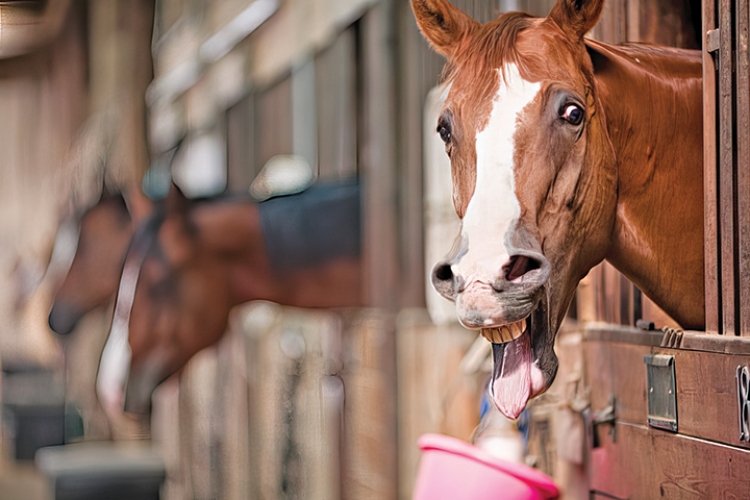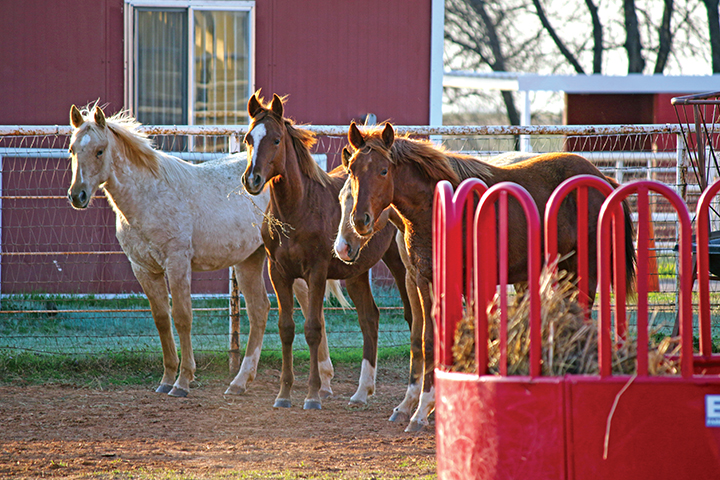
Stereotypies in Horses
by Heather Smith Thomas
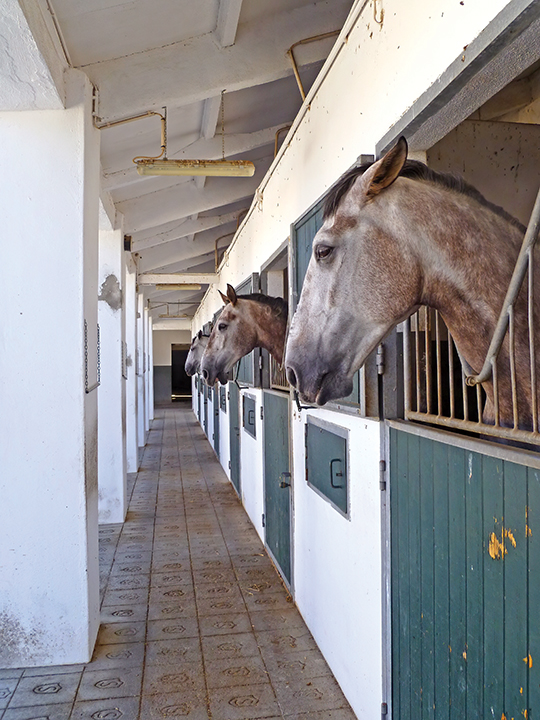
Domestic horses exhibit a number of behavioral problems that are never seen in wild, free-roaming horses. This is generally because we keep our horses in an artificial environment and don’t allow them to live ‘normal’ lives. The horse is a herd animal and functions best when living with a group, with room to roam and graze. Emotional stress of confinement and/or isolation from other horses can lead to cribbing, weaving, head bobbing, stall walking, stall kicking, self-biting and other repetitive actions called stereotypies.
These rhythmic actions by a confined or frustrated animal develop in response to stress - physical or psychological, with physical stress often leading to psychological stress. Examples of stereotypical behavior in other animals include paw-licking in confined dogs, cage pacing in zoo animals, feather plucking in caged birds, etc. In horses, repetitive actions have been called stable vices, but this is an inappropriate term. Vices are undesirable behaviors such as bucking or biting that can generally be corrected through proper handling and training. Stereotypies are obsessive-compulsive behaviors that are much more difficult to correct.
When a horse develops a compulsion, it’s a clue that something is seriously wrong with his environment; his needs for social interaction and security, mobility, or natural feeding behavior are not being met. Isolation, confinement, insufficient exercise or monotony can lead to compulsive behavior. Once established, however, a stereotypic behavior can become a need in itself and the horse insists on continuing with the behavior.
Underfeeding, restricted feeding or insufficient roughage (feeding concentrated feeds and limited hay or grazing) can be triggers for oral compulsions like cribbing--that later become preferred pastimes no matter how much feed the horse gets. Confinement is the usual trigger for locomotor stereotypies like weaving or fence pacing.
Most horses can withstand the frustration of a single social or physical deprivation if everything else in their lives is normal, but when several frustrating factors in the daily routine or stabling conditions converge (such as being kept in a stall and fed concentrated feeds that are eaten quickly, without enough roughage to nibble on through the day), he may go over the edge and begin a stereotypic behavior as a way to cope with the stress.
What Is A Stereotypy
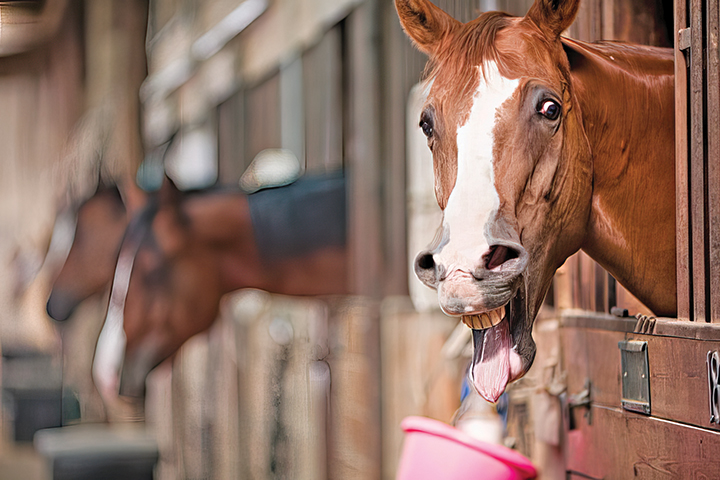
By definition, a stereotypy is a ritualistic and repetitive behavior that serves no known purpose. Stereotypical behavior is seen in about 15% of domestic horses and can be classified into two types--locomotion and oral. The amount of time a horse spends in these activities varies from horse to horse and may be random or associated with a trigger such as feeding time; many horses paw or kick their stalls or become more intense in their cribbing or weaving activities.
One of the main needs, and comforts, of any animal or human is food. When stressed psychologically, many individuals resort to some kind of replacement behavior that takes the form of an oral habit/compulsion, since eating is a way of coping with stress. Cribbing may develop originally from the horse’s compulsion to eat--chewing wood if nothing else is available--to ease his stress. Simple wood chewing can progress to cribbing with the horse pressing a wooden surface with his top incisors, letting his lower jaw hang slack, flexing his neck, opening his throat and pulling back with his mouth open--swallowing air with a grunting sound.
Once a horse starts cribbing, it quickly becomes an addiction. This compulsion can sometimes be triggered by eating sweet feed. Researchers feel that some types of food may be involved in development of stereotypies. Most of the oral stereotypies are related to a desire to eat, and restricted feed intake - the artificial high-energy diet we feed confined horses, with very little roughage - may be as much a cause as is the confinement and isolation.
The abnormal behavior develops over time and then becomes a pattern. If a horse does not feel full, he tries to go through the motions that normally would lead to eating such as chewing on something, which may then develop into cribbing. Most cribbers do their most intensive cribbing around mealtime, while impatiently waiting to be fed or when watching other horses eat.
Locomotor Stereotypies
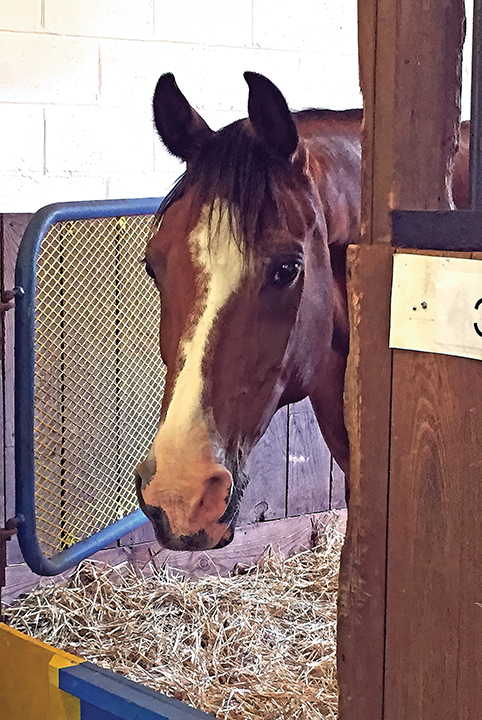
Stall or fence walking and weaving are the most common ambulatory patterns of stereotypies; the horse moves in a constant repetitive rhythm. A weaver remains stationary but sways back and forth, shifting weight from one foreleg to the other, usually standing in the same place in his stall or fence corner in a paddock every time he does it.
He may just shift his weight, rocking from side to side on his front feet, or may shift his whole forehand back and forth--almost pivoting in place. Some horses just bob their heads back and forth continually. Weaving usually begins because of frustration at being confined or separated from other horses, or from inability to graze. Weaving becomes the horse’s way of coping, especially when he discovers it can relieve stress and frustration through the release of endorphins in his brain.
Endorphin levels in his bloodstream rise when he performs stereotypic behavior. When these levels become high, he seems satisfied and stops weaving. When endorphins drop to a low level, he starts up again and becomes very intense in his weaving until the endorphin levels rise.
Similarly, a stall walker constantly circles his stall or paces back and forth in a certain pattern. A fence walker may pace in front of a gate or along one side of his paddock, usually the fence nearest other horses.
Dr. Jane Williams (Head of Research, Department of Animal and Agriculture, Hartpury University in England) and Dr. Hayley Randle (Associate Professor in Equine Science, Charles Stuart University in Australia) produced a review evaluating the impact of stereotypies on horses’ performance a few years ago. Williams says that from her perspective, if confined horses exhibit weaving or box walking, the additional activity and loading in the limbs could potentially increase their risk of musculoskeletal injury.
“They tend to favor walking in one direction over another, but there is very little research to support this. Cribbing also has the potential to cause incisor teeth wear over time and this could affect the horse’s dentition. Probably the most interesting aspect from the literature related to horses that exhibit stereotypies linked to performance is the apparent differences in how they learn,” says William.
“There are studies suggesting stereotypic horses learn associations more quickly and stronger, and take longer to ‘unlearn’ it, than non-stereotypic horses. This is great if the horse is taught well, but not so good if they ‘learn’ the incorrect responses to cues.”
Self-Mutilation Syndrome
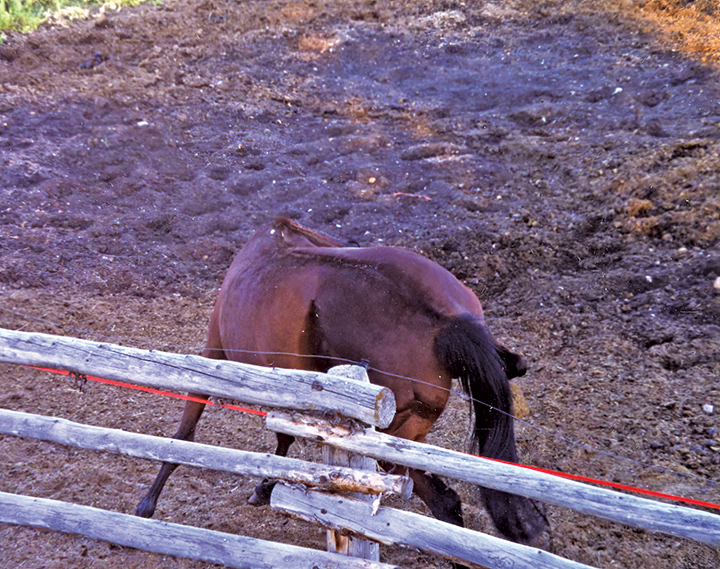
One of the most detrimental stereotypies in horses is self-mutilation. The horse bites at himself, often spinning around and grabbing his flanks. He may pin his ears back, gesture toward his flank, then suddenly lunge and squeal as he circles and nips at himself. Or he may make biting movements aimed at his legs, flanks or tail without actually making contact. Some horses take chunks of skin off with their teeth. Some make grunting or barking noises while nipping themselves.
This destructive activity occurs most often in male horses, especially confined stallions, perhaps because they are kept isolated from other horses. Early research on this problem was done at Tufts University, led by Dr. Nicholas Dodman in the 1980’s while doing research on cribbing. Self-mutilation in horses may have a genetic tendency but does not occur in horses under natural conditions; it seems to be brought on by stress and then the habitual behavior becomes addictive due to the involvement of body-produced opioids/endorphins.
Prevention And Treatment
The best remedy for stereotypic behaviors is preventative management, so a horse never has reason to learn to do them. Allowing horses more room for natural activities, feeding more roughage and less grain, or feeding smaller amounts more often so the horse spends more time eating and less time inactive, can help. Pasture time is best, but if this is impossible, devise ways to increase eating time, and give him a larger paddock or more time out of his stall. Provide ways for horses to be near other horses. Visual contact between stalls will often cut down on abnormal behavior. A companion animal may help some horses feel less isolated.
Young horses are more apt to develop stereotypies when brought into an unnatural environment than are older horses. Often a youngster that starts a compulsive behavior continues it throughout life, even if his circumstances change, since it has already become ingrained. Older horses are less apt to develop these behaviors when put into a confined situation, if they had a normal environment during their growing up years.
Any long-term confinement for a young horse presents higher risk for developing stereotypies. The best solution is to give young horses a more natural environment at pasture or in large paddocks, and with groups of their peers, rather than confined in stalls.
Treatment is generally not nearly as successful as prevention. Castration helps alleviate self-mutilation behavior in some stallions, but not others. Change in stabling or allowing a horse to be at pasture with herdmates, rather than confined in a stall or isolated in a separate paddock, may keep some horses from weaving or stall walking but they usually start it again if they are again confined. Change in environment generally won’t stop a cribber; he will find something to crib on out in the pasture. Treatment with narcotic blocking drugs that neutralize substances like endorphins is often effective, but the horse generally ceases his stereotypic behavior only as long as the drugs are in effect. The benefit is only temporary, and not a cure.
Dr. Sue McDonnell (University of Pennsylvania School of Veterinary Medicine Department of Clinical Studies, New Bolton Center) is a leading authority on equine physiology, behavior and welfare. She has studied stereotypies in horses and is often asked about these problems. Horses in many sports and disciplines are usually confined in stalls, which often leads to stereotypic behavior. Riders and trainers often wonder if these repetitive actions might have an adverse impact on performance. Overly-developed neck muscles in a cribber, for instance, might affect the horse’s balance and ability to get on the bit. The repetitive actions of a weaver or stall-walker might make a horse tired or result in tight muscles.
“Yes, these behaviors can impact performance. It stands to reason that the horse is using energy for something else, and there is some sort of stress or discomfort that led to these behaviors. Then it becomes a learned, reinforced habit because many of these behaviors release endorphins as the horse exerts or gets worked up. Current thinking is that the only humane thing to do is to try to figure out why the horse is doing the stereotypic behavior and try to alleviate and resolve that reason, rather than trying to thwart the behavior,” says McDonnell.
“You don’t want to add stress by yelling at the horse or punishing the behavior. It can be helpful to get a 24-hour video of the horse, because often the horse is only doing it when people are there. When you come into the barn and the horse is weaving, for instance, it appears that the horse is doing this all the time. It can be a relief for the owner or trainer to know that the behavior is simply related to feeding time or when there is someone in the barn,” she says.
There are some busy barns with people in them most of the day, and other barns where people are present for a limited time. “Everything that’s going to happen for that horse in that whole day happens during that brief time. If it is a predictable behavior and you can assure the owner/trainer that when everybody leaves the barn the horse settles down, comfortable instead of anxious, it can relieve their mind as they are trying to figure out if there’s a way to minimize this behavior when people are there,” she explains.
“When we do 24-hour evaluations, we sometimes find that the horse anticipates the arrival of the person and starts the behavior. Whatever cues it might be—like the sun coming up—the horse begins the anticipatory behavior.” If you always come to feed the horse at a certain time of day, the horse knows you’ll soon be there and starts anticipating feeding time.
“If the horse is a stall pacer or weaver, this activity often starts at that time every day. Many of these behaviors, especially cribbing, are associated with minor physical ailments, like gastric ulcers. People still argue about which comes first, the cribbing or the ulcers. Many of the behaviors, not only the stereotypies but also the gazing back toward the abdomen or turning the head to nuzzle behind their shoulder, occur when they are waiting for that highly palatable infrequent meal. They start cribbing and also start doing these other behaviors, which tells me that ulcers are bothering them,” she says.
Anything you can do to prevent or treat ulcers will generally reduce cribbing or locomotive stereotypies. “Some will do head nodding, and as soon as the sun comes up, they start nodding their head. It is an anticipatory anxiety and a well-known phenomenon even in people who are incarcerated when nothing they can do can change things. They totally depend on other people coming and doing something, so there is anxious anticipation. For people, they are thinking, ‘It’s almost time. They are going to come and let me take a shower, or eat, or whatever.’ Perhaps the confined or nervous person starts biting their fingernails or pacing, while the confined horse starts pacing in the stall,” says McDonnell.
With several serious problem horses that she took ownership of, as teaching animals, she tried to do a number of things—not only to help them but also to document their behavior for use in teaching. Some of those horses did better if their schedule was varied, but this is difficult to do because our human lives are usually on a schedule.
“If you don’t give these horses a fixed schedule they can anticipate, they often seem to be more relaxed until the immediate cues. I had one miniature horse that would circle in anticipation of feeding, so I put him on a schedule where the only thing that predicted my arrival to give him new hay was when I actually walked in the barn. We observed him on videotape and could see that he was quite comfortable until I walked in. Before that, we always interacted with him and fed him at a specific time each day, and he started what I interpreted as anticipatory circling in the stall,” she says.
“You shouldn’t do a really random schedule; you can’t feed a horse at 2 p.m. one day and at 4 a.m. the next. It can’t that erratic, but if you can randomize it a little, the horse won’t anticipate it as much and get worked up.”
“My horses at home are at pasture so this isn’t an issue, but in winter I give them supplemental hay. We don’t have free-choice hay bales, we just feed them twice a day. It’s interesting how they go about life as usual in the morning until they hear me start my car. I go out and start it and let it warm up for a few minutes while I go feed. In the evening, I feed them again. They know the sound of my car, versus my husband’s car, and it isn’t until my car comes in the driveway that they anticipate food—whether it’s at the regular time, or at 2 p.m. if I went home from work for some reason, or as late as 7 p.m. They become eager, thinking I am going to feed them,” says McDonnell.
Random feeding is not recommended for people who don’t understand the reasoning behind it because then they might think it doesn’t matter when they feed their horse. “It’s not an excuse to have unreasonable intervals between feedings.”
If a horse is a stall-walker or weaver or has some other undesirable repetitive behavior, it’s helpful to look at what that horse does during a 24-hour period on video. “That’s easy to do these days. You don’t have to be a trained behaviorist to observe your horse and understand what might be going on with that horse and what might be setting off those episodes. Your impression of how much the horse is doing this behavior is often much greater than it actually is,” she explains. It’s generally only triggered by human activity within the barn.
“Another thing the owner or trainer should do is advocate for that horse and not allow other people to add punishment to the situation, reprimanding the horse for undesired behavior. This just increases the horse’s stress and the state of mind that drives that kind of behavior, even though it might be satisfying to the person who walks down the barn aisle and shouts at the horse to interrupt the behavior. It makes you feel good, but after you pass by, the horse generally starts up again and the rate increases due to the increased stress,” she says.
It’s best to just ignore it. “You don’t want to reward it, like feeding them every time they do it, to distract them and make them stop. It’s best to provide no human consequence to what they do, so there is no reinforcement or stress. It’s very hard to do this, however, in a barn with multiple people because they all want to help with that problem horse. At one point we had a student here who drew cartoons and signs to put on the stall door to remind people what not to do with that horse,” says McDonnell.
“At that time, we had some Gypsy Vanners in the barn, and these stocky horses are prone to developing learned repetitive behaviors. When someone came in the barn they started pawing and banging on their stall doors. We have wooden doors, and it not only made a loud ruckus, but they could actually knock the door crooked on its track, which required a work order to fix. The student made some cute cartoons for various horses with stereotypies, and for the Gypsy Vanners the captions were ‘I’m a-knockin’ but don’t you answer!’ just to remind everyone to walk on by and not even look at that pawing horse. Eventually the barn atmosphere changed and no longer sounded like a drum corp. Some of the undesired behaviors will evaporate if these horses get no attention and you don’t reward or punish them,” she says.
“The learning studies and behavior studies that we’ve done over the years make it clear that any sort of attention when an animal is in this situation, where all of their life’s activities depend on someone outside the stall, just reinforces the behavior. In some instances, it can be perceived by the animal as punishment and adds to the stress. This is called a learned helplessness—feeling that nothing you can do can change things. But then the smart horses learn that if they make a big ruckus someone will come and give them attention. Whether it’s yelling at them or feeding them, it drives that behavior as reinforcement,” she explains.
If an owner or trainer is working with a weaver or stall-walker that is doing it so much that it affects that horse’s musculature, it might affect performance in more ways than simply using up energy. There may also be potential injury to feet and legs if they always walk or weave in the same direction or put more stress on one limb, or one side of the limb, than the other.
Cribbing Research Led To Understanding Stereotypies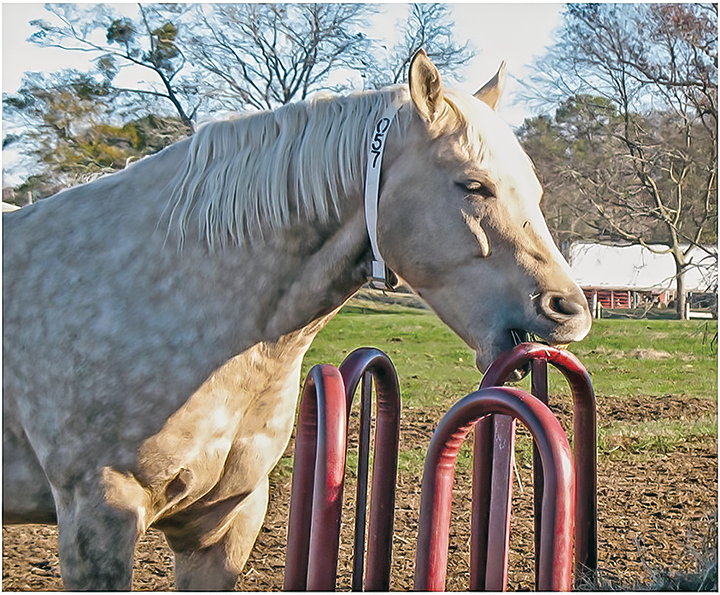
During the 1980’s, a team of scientists at Tufts University School of Veterinary Medicine in Massachusetts, discovered why horses crib and why this behavior is so persistent. It was found that horses given morphine showed an increase in stereotypic behavior such as cribbing. Sweet feed in the diet also increased these activities; very palatable feeds have been shown to increase release of endorphins in the horse, raising the pain threshold. Whenever an animal or human is stressed and engages in some type of repetitive activity as an outlet for pent-up energy, chemicals called endorphins are released in the brain. The constant activity triggers endorphin release.
Thus, when a horse starts a continual repetitive action such as stall walking, weaving or cribbing in response to confinement or stress, he may keep up the habit even when not confined or stressed, because he finds that repeating the pattern triggers release of calming morphine-like proteins (called opioids) which suppress pain and create a pleasurable sensation. Horses seem to relax and be “spaced out” after a cribbing or weaving session.
The act of cribbing or weaving causes a temporary sedating effect; the horse becomes addicted to his internal chemicals. The horse gets his fix by going through the repetitive behavior, and he craves the endorphins. This explains why many horses will actually stop eating and crib during the middle of a meal.
In experiments, cribbers were given narcotic blocking drugs that neutralize endorphins, and they ceased cribbing as long as the drugs remained in effect. Since the endorphins were no longer released to give the horses a feeling of pleasure, they lost the desire to crib.
The researchers felt that the frustration of isolation and confinement, or waiting for food, and the horse’s attempt to escape the frustrations were the cause of stereotypic behavior. As the stress increases, his escape attempts (which might at first be kicking the stall, walking around looking for a way out, pawing or biting the door) become increasingly frantic. Then he discovers that his frenzied actions are rewarded by a feeling of calm and well-being, brought on by release of endorphins. So, he repeats the action. Eventually the behavior becomes a habit pattern even if the stress is alleviated. The stall walker keeps pacing, the weaver keeps bobbing, and the cribber keeps cribbing. The behavior is an addiction, and difficult to halt once it begins.

